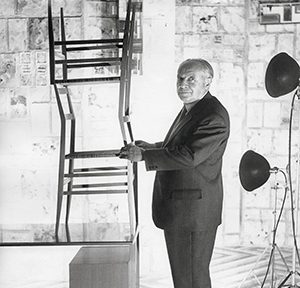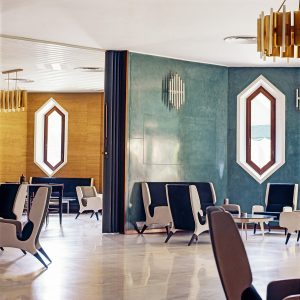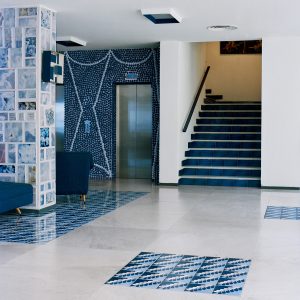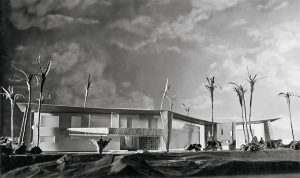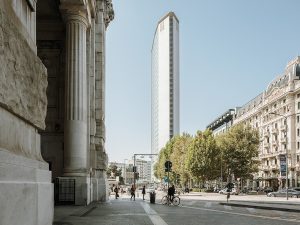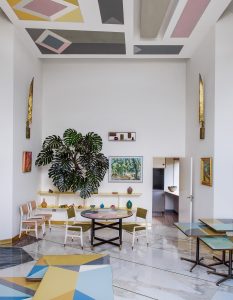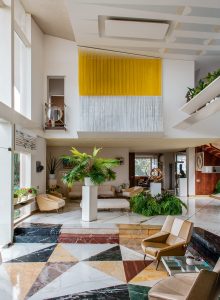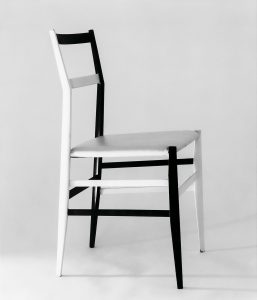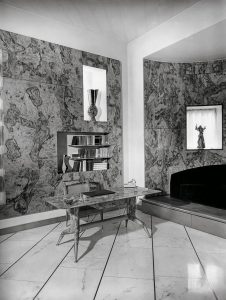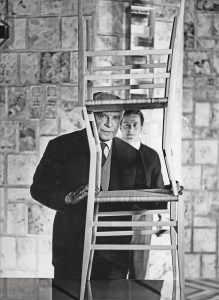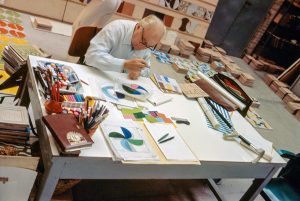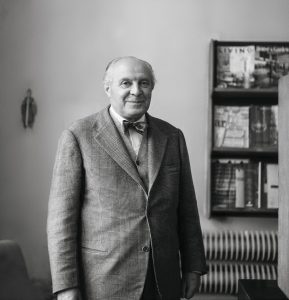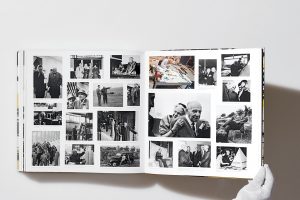Don Giovanni
Giovanni Ponti, kurz Gio genannt, wurde 1891 in Mailand geboren. Der Stadt, in der er 1979 starb, schenkte er ein ikonisches Nachkriegsbauwerk: Das Pirelli-Hochhaus entstand von 1956 bis 1958 in Zusammenarbeit mit Pier Luigi Nervi und Arturo Danusso. Im Laufe der Jahre realisierte er in der Hauptstadt der Lombardei zahlreiche weitere Gebäude: vom ersten, eigenen Wohnhaus über Wohnbebauungen und Bürohäuser bis hin zu Kirchen. Dabei ist sein Werk formalästhetisch stets am Puls der Zeit geblieben, räumlich jedoch immer überraschend, vor allem aber weit über die gebaute Umwelt hinausgegangen. Ponti ist eines jener Beispiele von Menschen, die an die Kraft gestalteter Dinge glaubten. Er stellte sich nicht die Frage, Hochhaus oder Gabel zu entwerfen, wo doch beides gebraucht und am besten im Sinne eines schönen Gebrauchs entwickelt werden wollte. Die Kaffeemaschine La Cornuta etwa, ein Entwurf aus dem Jahr 1948, gilt bis heute ebenso als Klassiker des italienischen Nachkriegsdesigns, wie der Stuhl Superleggera aus dem Jahr 1957. Die Weite des eigenen Horizonts und das ganzheitliche Verständnis von Gestaltung zeigte sich nicht zuletzt in der Zeitschrift Domus, die Ponti 1928 zusammen mit Gianni Mazzocchi gründete. Mit einer Unterbrechung in den Jahren von 1941 bis 1947 leitete Ponti das Medium, das sich gleichermaßen mit Kunst, Architektur und Design beschäftigte, bis zu seinem Tod. Und Lehrer war er auch – natürlich in Mailand. Am Polytechnikum fungierte Ponti von 1936 bis 1961 als Professor für Innenraumgestaltung.
 Ein Buch, in den Dimensionen ebenfalls bemerkenswert umfangreich, versucht nun, diesen Kosmos der Gestaltung nachvollziehbar zu machen. Herausgeber Karl Kolbitz hat den Prachtband in enger Zusammenarbeit mit dem Gio-Ponti-Archiv im Kölner Taschen Verlag vorgelegt. Er ist das Ergebnis einer rund zehn Jahre andauernden Arbeit. Salvatore Licitra hat die Inhalte des Buchs kuratiert, von Kolbitz kongenial in Form gebracht, und um ein kurzes Vorwort seiner Mutter – und Tochter Gio Pontis –, Lisa Licitra Ponti (1922–2019) ergänzt, die die Arbeit ihres Vaters über weite Strecken begleitete und bis 1979 Chefredakteurin von Domus war. Licitra, Fotograf, Künstler und Kurator, gründete 1996 im Atelier seines Großvaters Gio Ponti das nach ihm benannte Archiv. Mit Stefano Casciani, Brian Kish und Fabio Marino sind weitere Fachleute und Kenner des Werks von Ponti mit an Bord. Vor allem Cascianis ausführlicher biografischer Essay ist bemerkenswert detailreich und zeigt auch den Menschen Ponti, kontextualisiert durch die jeweiligen Schaffensphasen. 136 Projekte trägt das Buch zusammen: bekannte Schlüsselwerke und weniger beachtete Projekte, große Komplexe und schnelle Skizzen. Die Zusammenschau macht das Buch zu einer Art mobilem Studierzimmer. So werden etwa Zeichnungen in Kombination mit großformatigen Fotografien nachvollziehbar, da auch die Details der Projekte maßvoll ausgeleuchtet sind und ihre Bedeutung für das Projekt deutlich wird. Formen, Räume, Materialien, Häuser und Gebrauchsgegenstände – all das kommt hier zusammen.
Ein Buch, in den Dimensionen ebenfalls bemerkenswert umfangreich, versucht nun, diesen Kosmos der Gestaltung nachvollziehbar zu machen. Herausgeber Karl Kolbitz hat den Prachtband in enger Zusammenarbeit mit dem Gio-Ponti-Archiv im Kölner Taschen Verlag vorgelegt. Er ist das Ergebnis einer rund zehn Jahre andauernden Arbeit. Salvatore Licitra hat die Inhalte des Buchs kuratiert, von Kolbitz kongenial in Form gebracht, und um ein kurzes Vorwort seiner Mutter – und Tochter Gio Pontis –, Lisa Licitra Ponti (1922–2019) ergänzt, die die Arbeit ihres Vaters über weite Strecken begleitete und bis 1979 Chefredakteurin von Domus war. Licitra, Fotograf, Künstler und Kurator, gründete 1996 im Atelier seines Großvaters Gio Ponti das nach ihm benannte Archiv. Mit Stefano Casciani, Brian Kish und Fabio Marino sind weitere Fachleute und Kenner des Werks von Ponti mit an Bord. Vor allem Cascianis ausführlicher biografischer Essay ist bemerkenswert detailreich und zeigt auch den Menschen Ponti, kontextualisiert durch die jeweiligen Schaffensphasen. 136 Projekte trägt das Buch zusammen: bekannte Schlüsselwerke und weniger beachtete Projekte, große Komplexe und schnelle Skizzen. Die Zusammenschau macht das Buch zu einer Art mobilem Studierzimmer. So werden etwa Zeichnungen in Kombination mit großformatigen Fotografien nachvollziehbar, da auch die Details der Projekte maßvoll ausgeleuchtet sind und ihre Bedeutung für das Projekt deutlich wird. Formen, Räume, Materialien, Häuser und Gebrauchsgegenstände – all das kommt hier zusammen.
Neben der auf die ersten 1000 Exemplaren limitierten Art Edition – die mitsamt Arlecchino-Gitter-Couchtisch für 3000 Euro daherkommt –, gibt es auch eine Famous First Edition: 4000 weitere Exemplare der nummerierten Erstauflage, die es als Hardcover mit einer Größe von 36 auf 36 Zentimetern und fast sechs Kilogramm Gesamtgewicht durchaus in sich hat. Nichts für die Zugfahrt oder die Bettlektüre also. Dafür aber öffnet sich hier ein wahrer Kosmos der Gestaltung holistischen Anspruchs.
David Kasparek
BILDERGALERIE
- Interior of Villa Arata, Naples, 1952. The double reception room’s furniture was all designed by Ponti and made by Cassina, 1950. Ponti’s “organized wall” unit was made by Giordano Chiesa in 1952, and was filled with ceramics by Fausto Melotti, as well as by Ponti for Richard-Ginori. In the dividing wall, resting on the ledge of the interior window, are Ponti’s glass tumblers with a Fulvio Bianconi bottle, all by Venini, 1948. The ceramic floor tiles were made by Gabbianelli, 1950. Photo © Gio Ponti Archives/ Historical Archive of Ponti’s Heirs.
- Gio Ponti. Art Edition – Edition von 1.000 Exemplaren
- Hotel Parco dei Principi, Rome, 1961–64. View of the banquet room. Interior walls are covered in colored ceramic pebbles produced by Ceramica Joo, and embellished with hand-printed curtains made by Jsa. The room is illuminated by ceiling lights realized by Osvit, and furnished with chairs and tables produced by Cassina. Photo © Gio Ponti Archives/ Historical Archive of Ponti’s Heirs.
- Hotel Parco dei Principi, Rome, 1961–64. View of the lobby. The walls are covered with “Grass Cloth” wallpaper by Braendli and teal-green “Sigmulto” stucco by Sigma. The space is furnished with armchairs and sofas (model 899) and coffee tables produced by Cassina. Wall sconces and ceiling lights were designed by Ponti with Emanuele Ponzio, realized by Candle, 1960. The hexagonal bronze window frames were manufactured by the Del Vecchio factory of Fano. Photo © Gio Ponti Archives/ Historical Archive of Ponti’s Heirs.
- Hotel Parco dei Principi ‘Villa Siracusa’, Sorrento, 1960. View toward the stairs. Ponti adopted different designs to clad the vertical surfaces of the lobby, combining the colored pebbles produced by Ceramica Joo with the ceramic panels realized by Fausto Melotti. The ceiling lights are by Osvit, while the wall sconce is by Arredoluce. Photo © Allegra Martin/Courtesy Collezione Fotografia MAXXI Architettura.
- Project for Villa Guzman-Blanco Caracas, Venezuela, 1958. Photomontage with the architectural scale model of the villa. Photo © Gio Ponti Archives/ Historical Archive of Ponti’s Heirs.
- Interior Design for Alfredo Beracasa, Caracas, Venezuela, 1956. A sketch of the interior in which Ponti schematically delineates furniture and colors. Photo © Gio Ponti Archives/ Salvatore Licitra.
- Pirelli Tower, Milan, 1956–60. Photo © Luca Rotondo.
- Interior of the Villa Planchart, Caracas, Venezuela, 1953–57. View of the main dining room. The painted tabletops, fragmented marble floor slabs, and illuminated ceiling that is partially in relief visually engage together. All tables and surface designs were custom designed by Ponti and made by Giordano Chiesa. Ponti also designed the elongated and salient brass wall sconces, custom-made by p. 349 Arredoluce, 1957. The door to the right leads to the main kitchen. Photo © Antoine Baralhe.
- Interior of the Villa Planchart, Caracas, Venezuela, 1953–57. The main double-height reception room, which is split on two levels, each defined by a distinct floor pattern and furniture arrangement. In the foreground, Ponti debuted his Mariposa armchairs (Cassina, model 851 of 1954), made by Cassina, in leather upholstery. At the back, a set of armchairs and a sofa from the Diamond line (also of 1954). Hanging above, there is a sitespecific installation by Jesus Rafael Soto, added after Ponti completed the villa. To the left, a small loggia, with a moon emblem, leads to the master bedroom. A secondary balcony with a sun emblem is directly opposite across the space, in front of the guest bedroom. Photo © Antoine Baralhe.
- Villa Planchart, Caracas, Venezuela, 1953–57. The large carport with a dramatic cantilevered canopy is on the south side of the villa. This entrance is also the access point to the service areas at the back of the house: kitchen, laundry, storage, and offices. Photo © Gio Ponti Archives/ Historical Archive of Ponti’s Heirs.
- Superleggera (model 699) for Cassina, 1957. Black-and-white painted version of the Superleggera (model 699), emphasizing the dematerialization of the form by Ponti’s “positive/ negative” method. Made by Cassina, 1957. Photo © Gio Ponti Archives/ Historical Archive of Ponti’s Heirs (Photo Giorgio Casali).
- Prototype of sterling silver flatware, the “Diamond” line, produced for the American market, made by Reed & Barton, Rhode Island, 1954–57. Photo © Gio Ponti Archives/ Historical Archive of Ponti’s Heirs.
- Interior Design for the Ceccato Apartment, Milan, 1950. Main reception room with central table as desk, in Ferrara burr walnut, as are sections of the wall paneling. Two illuminated recessed shelves display ceramics by Fausto Melotti. Photo © Gio Ponti Archives/ Historical Archive of Ponti’s Heirs.
- Cover of Domus 270, May 1952, showing the main reception room at the Vembi-Burroughs company in Genoa. Ponti designed the large display table, which was also used for secretarial training of the company’s products. The rubber floor was Ponti’s “Giallo fantastico” made by Pirelli. Courtesy Editoriale Domus S.p.A (Photo Ancillotti). p. 240 14 Interior Design for
- Colored drawing with letter to Lisa Licitra Ponti, felt-tip markers, ca. 1960s. Photo © Gio Ponti Archives/ Salvatore Licitra.
- Cover of Domus 326, January 1957. Cover by Gio Ponti, showing his patterned floor surfaces using white marble slabs interspersed with sections of black cement with black stone insets. Produced by Fulget. Courtesy Editoriale Domus S.p.A.
- Gio Ponti and his son Giulio at the New York Alitalia offices, with the Superleggera chairs produced by Cassina, 1957. Photo © Gio Ponti Archives/ Historical Archive of Ponti’s Heirs (Photo Dan Wynn).
- Lisa Licitra Ponti and her father Gio Ponti in the garden of the studio in Via Dezza, Milan. Ponti is showing her the model of a WC for Ideal Standard, 1953. Photo © Gio Ponti Archives/ Historical Archive of Ponti’s Heirs (Photo Klein).
- Gio Ponti designing ceramic floor tiles at the Ceramica D’Agostino factory in Salerno, 1964. Photo © Gio Ponti Archives/ Historical Archive of Ponti’s Heirs.
- Gio Ponti in his architecture office in Via Dezza, 1964. Photo © Universitа Iuav di Venezia – Archivio Progetti, fondo Giorgio Casali.
- Large vase for Richard-Ginori from the “Prospettica” series, painted majolica, 1925. Photo © Gio Ponti Archives/ Salvatore Licitra.
- Coffee table with metal-grid top, 1954. Coffee table with metal-grid top, made by Giordano Chiesa. Ponti initially used this version for Villa Arreaza in Caracas, with later variations for the Alitalia offices in New York and his own apartment in Via Dezza. It was also put into a small production for the Swedish store, Ferdinand Lundquist, in 1955. Photo © Gio Ponti Archives/Historical Archive of Ponti’s Heirs.

